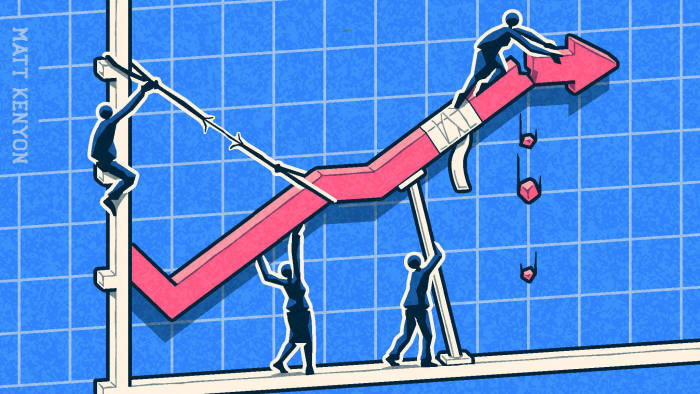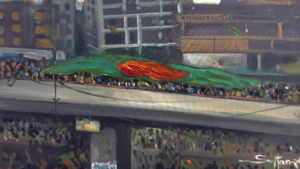
COVID-19 has exposed the fallacious estrangement, alienation and segregation in social relations. As the contagion dispersed from local households to firms to the global sphere, distorted messages were circulated, particularly in the name of social distancing. The official narrative serves at instigating social profiling that has been worsening worldwide in recent times. Nevertheless, a good many citizens have come up with the phrase of physical distancing instead, emphasising social solidarity. They have come forward to distribute relief to people living hand-to-mouth and the frontline workers are putting in utmost efforts. On the eve of the Bengali New Year, social media was flooded with messages reverberating ‘may we reunite when all this ends, may we emerge triumphant’ whilst many others have echoed ‘let there be an end to this pandemic, breaking all shackles of contagion.’
The citizens are aspiring for a transformational mission for a legitimate state to provide for universal basic needs and to ensure fundamental rights of its citizens. On the economic front, the crisis begs a thought-thorough strategic framework to transcend to transformational medium and long-term pathways with an emphasis on the needs of the vulnerable.
A shift from conventional budgetary system to a three-year resuscitation strategy for Bangladesh is the need of the hour to inhibit the contraction of the economy. The medium-term macroeconomic framework, through coordinated fiscal and monetary policies, will have to centre on employment to control erosion and increase income.
State of economy and shutdown relaxation
THE economy had been in distress before the strike of the pandemic with jobless growth, slowed-down poverty reduction, declined export-import and unfulfilled targets of revenue collection. There has been a liquidity crisis in the banking system as the government grabbed the yearly target of borrowing in six months.
COVID-19 blatantly points out the state failure in provision of universal basic needs such as food, health, social security, education, etc. From those living hand-to-mouth to those in the lower-middle class, the citizens are facing an existential threat as they starve and remain out of jobs in the absence of a fully-fledged social security system. A large population is also out of the minimum wage jurisdictions and is deprived of basic amenities as they are employed in informal sectors. The existing social safety net programmes are inadequate and marred with leaks. The health and education sectors are fraught with negligence and decreasing budgetary allocations. The pandemic has also laid out in the open the frailties of the real sectors — agriculture, manufacturing and services.
Given such contexts, there are discussions regarding the opening up of the economy. First, any relaxation of the shutdown has to be based on science. The shutdown, with its varied enforcements, have resulted in reduction in transmission and mortality despite limitations of the data. One way to understand the dynamics of transmission is to look at the basic reproduction threshold. If the basic reproduction or R nought is greater than one, the virus will spread exponentially. If the reproduction ratio is less than one, the infection will spread slowly and will eventually die out. The country has not yet reached the level of one. This is complementary to ‘flattening the curve’ public health strategy through which the spread of the epidemic is slowed down so that the peak number of people requiring care at a time is reduced and the pressure on health care system does not exceed its capacity.
Any policymaking on the withdrawal of the shutdown will not put the people in a binary proposition of lives versus livelihood or place a higher value of a life or livelihood in a country compared with others. It rather should devise a comprehensive strategy consisting of a phased approach to relaxation of the shutdown with stringent guidelines by striking a balance between lives and livelihood. A single-minded withdrawal of the shutdown prioritising livelihood will have adverse ramifications for both in view of paucity of health infrastructure.
A phased step-by-step strategy has to contain inbuilt threshold indicators relating to reduction in risks for relaxing the shutdown for a sector, region and demographics. The sufficient condition is the enhancements of diagnostic and surveillance tests, tracking and contact tracing, which are still hugely inadequate. The decision making necessitates a consultative approach involving stakeholders.
And most importantly, if the shutdown is withdrawn, earnings by the low-income rungs are not automatic. As a significant amount of citizens are facing an existential threat in the absence of a fully-fledged social security system, the provision of a universal basic income grant of Tk 15,000 through the banking channel for six months is a must. There are around 20.52 million bank accounts of this stratum, according to the Bangladesh Bank, which can serve for cash transfers. National identity cards may be used to open bank accounts and cards can be issued on an emergency basis who do not possess such. There is also a need for the issuance of food card against the national identity cards to allow access to public food distribution.
A three-year recovery plan
THE prime focus of the three-year plan has to be on the sectors relating to universal basic needs and on the retention and creation of employment, particularly in view of erosion of income and unemployment, aggravated by pre-crisis high unemployment and underemployment due to jobless growth and shortages in skills.
COVID-19 demonstrates the failure in the state provision of universal basic needs as the emphasis has been on capital accumulation emphasising exchange values, including financialisation at the cost of use value generating sectors such as health and education. This originates from a misconstrued ideology that market is the organising principle and society is equivalent to market. Rather market is subordinated to social, political and cultural norms. The use-value producing public goods is indispensable for augmenting capabilities of citizens to transform economic structure, political settlement and organisation of society. Under such circumstances, fulfilling the basic needs of citizens must be the foundation of the policy framework in any legitimate state. For instances, the private sector-dependent healthcare system has to be reformed to establish a universal national health system and a fully-fledged life-cycle-based social security system is required to serve the people in need.
The real sectors had already been at risk in the pre-crisis period. The agriculture sector is fraught with inadequate technological advancements and increased input prices. Simultaneously, the manufacturing sector witnessed a gradual concentration, tainted by low productivity, subdued competitive advantage and truncated product diversification, and an eventual fall in export volume. The drop in inflow of remittances has been adversely affecting the rural economy. The rate of reduction in poverty diminished because of lesser employment and a drip in return on labour. Inequalities in all forms are mounting. Illicit outflows of capital have been on the rise. There are frequent collapses in the capital market.
The public spending — the money of the public — shall only be allocated to create multiplier effects in an economy, provide public goods and address externalities — negative and positive. The public spending is not meant for a few at the expense of many — clientelistim must be checked. Incentives should only go to employment-generating real sectors, with minute details such that enterprises matter, but it is job that counts. Mission-oriented policies can create multiplier effects as well as accelerate growth. Pushing economy to the next rungs as the country aspires to be a middle-income and eventually a developed country warrants a transformative production pathway, ensuring a cleaner, greener and stable production system.
Universal basic needs: social security, universal healthcare and education
MARGINALISED populations, especially those living hand-to-mouth, employed in the informal sector are the worst victims of the crisis. The ongoing predicament has manifested the pitiful state of the low income population with no savings. The objective of keeping poverty below the international poverty line dictates the dire need for social security as the imminent recession will lead to loss of employment, pushing more people into poverty. The social security system has to include, amongst others, income support, national health services, child benefits, housing benefits, disability living allowance, invalid care allowance, state pension, job seekers’ allowance. Around 6 per cent of the GDP can be spent in the next budget on social security, which is as high as 11 per cent or more in several countries.
The health sector has been in shambles because of trivial budget allocation, inadequate equipment, deficient infrastructure, low-quality service and high out-of-pocket expenditure. Every citizen may be brought under the auspices of universal health care through the distribution of national health cards based on their national identification cards. While this is under implementation, a health allowance can be provided for the poor. The extra expenditure required for the provision of a family doctor, nurse and infrastructure may be financed by tripling the current budget allocation on health.
The absence of universal education implies that quality education can be availed only by the few, thereby resulting in a skills mismatch. Decent jobs can only be created through improving skills levels. Higher education has been failing in creating new knowledge, skills development and active citizenship. An escalated allocation to the tune of 4.25 per cent of the GDP can be earmarked for education, technology and research.
Diversification and productivity enhancement in agriculture
AROUND 40 per cent of the population depends on agriculture. The limited drive for diversification has not unleashed the potentials. A far-reaching contemplation has to be undertaken in the sector in terms of production and processing. Otherwise, the rural-urban migration may worsen and so will the consequences of an increased import dependence.
To ensure food security for all, the government should embark on direct purchase from farmers to ensure fair farm-gate prices and to keep retail prices affordable. Financial subsidies for fertiliser, seeds and pesticides ought to be continued along with debt relief to maintain the cycle of production for aus and aman seasons. The association of farmers, poultries, hatcheries and dairy farms can also be mobilised to avoid leaks in distribution of subsidies. These actions would require a 150 per cent increase from the current budgetary allocation.
In total, 669,377 migrant workers, including half a million wage labourers, have returned home since January. Amongst them, around 293,000 individuals have returned in the first 20 days of March only. Given the drop in oil price, Middle Eastern countries may reduce their dependence on oversees workers. This may put a dampener on the retention of and hiring migrant workers and the consequential loss of income from remittance will undoubtedly have a negative impact on the rural economy.
Diversification, competitiveness and technological capabilities in manufacturing
THERE is a dearth of prudent planning in the manufacturing sector, exhibited by over-reliance on export orientation with concentration in a single sector. The entire manufacturing process must undergo drastic makeovers with a balance between domestic consumption and export orientation. While domestic consumption must be raised in order to enhance domestic capability, concerted efforts have to be made to diversify the export destinations, particularly targeting the neighbouring markets of India and China. Thus, specific strategies should be formulated by examining the nature of demand and institutional realities in these markets.
The thrust has to be on the enhancement of domestic capabilities through diversification, productivity augmentation, technological catching up and increased competitiveness in agriculture, manufacturing and service sectors.
Three mission-oriented equity matching facilities — the green industrialisation fund, the diversification fund and the nationwide rural area regeneration industrial fund — can be established to address the massive changes in the post-COVID era, mobilising SMEs and start-ups, and the large firms, with the objectives of employment creation, product diversification, value addition, greening and alternative export creation. To curb the concentration of industrial activities on a few centres, the nationwide rural area regeneration industrial fund can finance an integrated solution, comprising of industrial plots, utility services including gas, electricity, along the national highways and waterways, creating growth centres across the country. Such would require a six-fold increase in budgetary allocation.
Financial assistance and subsidies, tax holidays and tax exemption at different stages should be disbursed in accordance with the outcomes and targets. Until now, the clientelist networks have been the recipients and the funds have evaded as illicit capital outflows.
Use of oceanic and water resources
THE potentials of marine and water resources are yet to be tapped despite numerous discussions on the ‘blue economy’. The country is still unable to delve into the deeper parts of the Bay of Bengal, a capability that can only be achieved through technological advancement.
Sources of revenue and deficit financing
THESE undertakings of the three-year recovery plan will require a sizeable volume of financing. The shrinkage of the economy is leading towards declined income and value added taxes and custom duties. Under such circumstances, the government has to embark upon a concerted strategy. First, unnecessary expenditures such as capacity charge subsidies in power sector, government largesse and cost over runs will have to be reduced without resorting to austerity measures. Second, the government should look for easily accessible sources of revenue the likes of at least having 1.5 billion dollars from undocumented foreign workers in Bangladesh, the activation of transfer pricing cell to reduce tax avoidance and re-examination of tax exemptions given to politically influential conglomerates. Third, efforts shall be made to increase foreign aid from bilateral and multilateral sources. Fourth, obtaining multilateral and bilateral loans with low rate of interest, longer repayment and grace period shall be the priority to ease debt servicing, besides seeking relief, writing off and deferrals of debts. Fifth, the government has to primarily source from the central bank even if this requires printing of the currency as banks are already in liquidity crisis and treasury bills and savings certificates are costly. Hence, an out of box flexible functional finance-based creative non-traditional strategy is the way out of the crisis.
For the suggested budgetary allocation, the budget deficit may touch 10 per cent of the GDP. This is not the time to be concerned about the budget deficit and the debt-GDP ratio, which is at an acceptable 30 per cent level. It is often postulated that higher spending by government is anticipated by the consumers as a rise in future tax, which lead them to cut back on consumption and save more in order to compensate for future expenses. In reality, this is not the case. As investment, consumption and export decline during a recession, the government needs to spend more on offsetting the contraction of, and increase in, the GDP as these four constitute the GDP. In order to finance the additional expenditure, a government during recession borrows money which is eventually paid off as revenue increases when the economy recovers.
There is no possibility of a runaway inflation given the current depressed consumption spending and slackened production. Inflation results from nominal spending surpassing real capacity of producing goods and services in an economy. It is, therefore, imperative to inject cash and go for the issuance of new money, if needed, to curb the contraction as money is a creature of the state at all times. The interest rates can also be further adjusted on a gradual basis, reflecting the need, without worrying too much about inflation.
Preparing for a new order
COVID-19 has emerged as the harbinger of changes in social, economic and political structures worldwide. In the absence of a radical transformation, the economy is expected to enter a prolonged stalemate, as well as, there maybe be severe blows to social stability. The manner in which this change will manifest itself will depend on the nature of relationship between the state and its citizens.
The transformation of an economy, thus, entails an active citizenship as a sufficient condition, which can only claim accountability of the state and ensure a command over authorities and public resources. The history of global development postulates that development is not only subject to the state or market or capitalism. The key ingredient is organizational capability, consisting both formal and informal institutions. A failure in achieving institutional capabilities will deprive citizens from the fruits of development whilst benefiting only a chosen few, heralding the need for a new social contract.
In order to transform this relationship, the state capacity will undeniably have to improve, and foreign and national defence policies are to be devised accordingly. The political farsightedness will determine how successful the country will be in making the most out of a changed global atmosphere. The political settlement is only effective when there exists accountability of the state to its citizens.
Publisher earlier in New Age
Thumbnail source: ft.com





